| This blog explores social attitudes in Jane Austen's time, discusses her novels, reviews forgotten 18th century novels, and throws some occasional shade at the modern academy. The introductory post is here. My "six simple questions for academics" post is here. |
| She alone was sad and insignificant: she had no share in anything; she might go or stay; she might be in the midst of their noise, or retreat from it to the solitude of the East room, without being seen or missed. She could almost think anything would have been preferable to this. -- Fanny Price at her most Eeyore-ish in Mansfield Park |
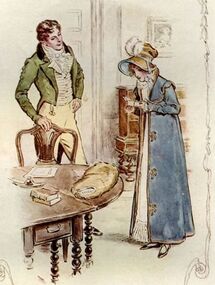 Edmund and Fanny in the East room
Edmund and Fanny in the East room Once that narrative interlude ends, we return to Fanny's conundrum. Should she acquiesce and join in the private theatricals, which she disapproves of on the grounds of propriety, and in addition, she doesn't want to act? As Fanny is pacing and thinking, Edmund visits her, to tell her he plans to relent and take a part in the play Lover's Vows. He and Fanny both know Sir Thomas would disapprove, so Fanny can't give him her whole-hearted concurrence.
Edmund awkwardly tries to segue out of the uncomfortable disagreement by talking about her books: “[Y]ou will be taking a trip into China, I suppose. How does Lord Macartney go on?” He babbles nervously: “And here are Crabbe’s Tales, and the Idler, at hand to relieve you, if you tire of your great book. I admire your little establishment exceedingly; and as soon as I am gone, you will empty your head of all this nonsense… and sit comfortably down to your table. But do not stay here to be cold.” And poof! he’s out the door, down the stairs and down the hill to Mary Crawford at the parsonage...
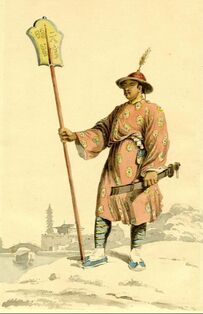 Chinese standard bearer by William Alexander, official draftsman for McCartney's visit to China
Chinese standard bearer by William Alexander, official draftsman for McCartney's visit to China Edmund hopes the descriptions of the fabled, the almost mythical Orient in The Embassy will transport Fanny far, far away, so she'll have something more consequential to think about than his about-face on the propriety of private theatricals. Although on this occasion taking refuge in "her little establishment" did not divert Fanny from her worries, the East room has certainly fired the imaginations of Austen scholars. As Kirstyn Leuner puts it: "Fanny Price’s East room in the Bertram estate attracts not only characters in Jane Austen’s 1814 novel Mansfield Park to knock on its door and peer inside, but literary scholars as well." While “there was no reading, no China, no composure for Fanny," contemplation of the East room has sent scholars on a quest for meaning, and lo, they return, not laden with tea and silk and spices, but with rich and subtle symbolism. One scholar notes Fanny's chronic invalidism and suggests the room is a "sick space" where she can "rest and reflect," even though cruel Aunt Norris denies her a fire.
One scholar has drawn parallels between the power struggle between Fanny Price and the Bertrams and Lord McCartney’s negotiations with the Chinese emperor. Others see the room as the British Empire in microcosm. “Intellectual history, material history that combines the social and the aesthetic, and Britain’s colonial geopolitical history coalesce in Fanny Price’s East room…. Fanny’s belongings in the East room [include objects] enabled by colonial enterprise.” The East room is compared to an art gallery or the British Museum and Fanny to a curator.
Well, any room in a prosperous gentleman’s house is going to include material objects which are the products of imperialism, as well as chinoiserie of all kinds. I'd expect you'd find more of these objects in any room in the house other than the old school-room, though. I think it is more accurately described as (name) describes it, "a motley assemblage of household detritus."
| East is East and West is West Surely, the “East” in “East room” is significant? One scholar opines that Fanny’s room is “appropriately called the East Room” because it conjures “a growing global awareness.” It draws our thoughts toward the East, where the East India Company clippers plied the waves between Canton and Madras and Calcutta before returning to the docks of London. Another scholar points out that the "east has significant Christian resonances" as the Star of Bethlehem appeared in the east. Another scholar recognizes that if the East Room represents British expansion and Fanny colonizes it, oops, that's a little problematic: "That the taking over of new territory (by Fanny, by Sir Thomas and his class) happens ‘so naturally’ would imply no opposition to these acts of geographical expansion, which of course belies historical facts regarding the colonies at this time..." Another scholar agrees: "Fanny’s acquisition of more space, her taking over of what they call the ‘East room’, might encode the larger territorial expansion of British land possessions." Or, it might not. John Wiltshire excuses Fanny on the grounds that she never chose to be removed from her home in Portsmouth and transplanted to Mansfield: "The East room in fact is the very emblem of Fanny’s condition as a displaced person. It’s a room of her own, but not quite." Some scholars point to the physical location of the East Room as being significant in terms of Fanny's slowly rising importance to the family. She has been granted, or alternately has claimed, this territory in the no-man's-land between the little white attic and the main spaces in the house. The East Room is a half-way point on her journey from insignificance to prime importance to the family, as she becomes by the end of the novel. It "reflects Fanny's gradual estrangement from Portsmouth and eventual identification with Mansfield," John Skinner suggests. Manuel Schonhorn, after reviewing all the other mentions of the direction "East" (such as east wind) in the novel, waxes rhapsodic over the East Room: | I have spent some time in classrooms in China. The architect of the school where I taught designed the building to take advantage of natural light. The school was built around an open courtyard, not for aesthetic reasons, but so the corridors had windows. The outer walls of the classrooms had windows and clerestory windows ran along the tops of the interior walls. No artificial light needed. These designs saved money on electricity. And in Austen's time, daylight was preferable to candle-light and firelight for working and reading, for obvious reasons. Incidentally, just as Fanny did not have a fire, the college radiators never made it past a feeble lukewarm in the winter. If you put your hands directly on them, you might sense some warmth. The students and I wore our coats, and sometimes gloves, in class. More about my time in China if you click the subject "China" at upper right. |
After all the elaborate interpretations of the meanings of the East Room, I am going to sound very prosaic, but here goes: the East Room is called the East Room because it faces east. Why am I so certain? Because it was the school-room. Is this fact so obvious that all the other interpreters of the East Room thought it did not require to be mentioned, or have they all lost sight of the essential facts of the choices people made about room orientation in the days before gas or electric lighting?
Rooms that faced east got the morning light. And incidentally, the “aspect” of the East Room is so favourable that it stays tolerably warm in the morning without a fire, thanks to passive solar heating.
The Gentleman’s House, published in Victorian times, advises: “The light [in the school-room] ought to be abundant, for various educational reasons.” A description of an Irish mansion specifies that the “Gentleman’s room” —that is, the room men used for business, going over their books, meeting with their bailiff and steward— “is lighted from the North and East.” We recall that soon after Lady Catherine de Burgh enters the Bennet’s parlour, she announces: “This must be a most inconvenient sitting-room for the evening in summer: the windows are full west.”
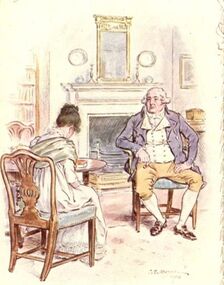 The East room doesn't look too shabby in this Brock illustration.
The East room doesn't look too shabby in this Brock illustration. Secondly, before delving into the hidden symbolic meanings behind the East Room, or get lost in discussions of how Austen "reconfigures the material spaces of her life and her texts... thereby simultaneously (re)building female subjectivity." why don't we first look at the role the room plays in the plot.
Consider the East room from the point of view of a writer. Consider for a moment the needs of the plot. What happens in the East room? It hosts a number of private—and important—conversations between Fanny and Edmund, Fanny and Mary Crawford, and Fanny and Sir Thomas. And it also hosts a rehearsal of a love-scene between Mary and Edmund, with Fanny as unwilling looker-on, one of the many scenes in which Austen sets up our heroine so we can watch her being emotionally tortured. Later in the novel, Fanny stays in the breakfast room, hoping to avoid a conversation with Mary before she leaves Mansfield, but "Miss Crawford was not the slave of opportunity." She steers Fanny up to the East room, the only place where "they might be secure of having four walls to themselves."
Could any of these scenes take place anywhere else? Outside, possibly, in the shrubbery, if the weather was warm enough and it wasn't raining. Fanny does have several important conversations outdoors, away from the servants and everyone else. But the rehearsal scene between Edmund and Mary, and Mary's tender recollection of it, could logically only have taken place indoors.
Can Fanny entertain Edmund in her poky little bedroom? No, because although they grew up like brother and sister, she is going to marry him later. For this same reason, despite what scholar Kirstyn Leuner suggests, Fanny would not use the East room as her "dressing room." The text of Mansfield Park specifically notes that she gets dressed for the ball in her bedroom, not the East room.
Could she have had these conversations down in the sitting room? No, in any of the downstairs rooms, the conversations might be overheard or broken in upon. Austen demonstrates this when she shows us that both Sir Thomas and Edmund have to intervene to keep Mrs. Norris from intruding herself when Fanny and her brother William are reunited in the front hallway after a separation of seven years. And even then, the encounter is not private because there are servants there, opening and closing doors.
Once, Fanny places a conversation between (the adult) Edmund and Fanny on the staircase going up to the second floor, “and the appearance of a housemaid prevented any farther conversation.” That conversation is deliberately broken off by Austen.
Without the East room, Fanny would have to run out to the shrubbery every time she needed to have a private word with someone. Or Edmund would need to give her the gift of a necklace on the stairway or, heaven forbid, in the sitting-room in front of Aunt Norris and you know how that would have gone.
Instead, we learn in Chapter 16 that Fanny had, for some time although it hadn’t been mentioned yet, been using the East Room for her private sanctuary. The narrative passage is a bit of backstory, but also takes us into Fanny's inner feelings and thoughts.
That’s why the East Room comes into the novel, but not before. It becomes necessary for plot purposes.
When you ask yourself, why does Austen do such-and-so? or in this case, what's the big deal with the East room? You can start by asking yourself, what would have happened if this wasn't in the novel? And in the case of the East room, it would have meant Fanny had no indoor space where she could have a private conversation or even have a moment to herself. A commentator on the “Reading Jane Austen” podcast remarked: "I experienced the introduction of the East Room in Chapter 16 as a real turning point, because that is where you get the first extended section of Fanny’s internal deliberations. And it comes right after Mrs. Norris’s insult in the chapter before—just when a reader would want to know how Fanny survives in such an environment."
Whether the East room means more—whether it's symbolic of Fanny's solitude, or of her growing independence, or of the contemplative life of a nun, or of both consolation and oppression because of the objects accumulated within it,is a simulacrum of Empire, colonized by Fanny, I will leave to others. But I think analysis of the East room might start with the basic facts I've mentioned here.
| Austen's description of the East room: Mansfield Park, Chapter 16, excerpt: "The little white attic, which had continued her sleeping-room ever since her first entering the family, proving incompetent to suggest any reply, she had recourse, as soon as she was dressed, to another apartment more spacious and more meet for walking about in and thinking, and of which she had now for some time been almost equally mistress. It had been their school-room; so called till the Miss Bertrams would not allow it to be called so any longer, and inhabited as such to a later period. There Miss Lee had lived, and there they had read and written, and talked and laughed, till within the last three years, when she had quitted them. The room had then become useless, and for some time was quite deserted, except by Fanny, when she visited her plants, or wanted one of the books, which she was still glad to keep there, from the deficiency of space and accommodation in her little chamber above: but gradually, as her value for the comforts of it increased, she had added to her possessions, and spent more of her time there; and having nothing to oppose her, had so naturally and so artlessly worked herself into it, that it was now generally admitted to be hers. The East room, as it had been called ever since Maria Bertram was sixteen, was now considered Fanny’s, almost as decidedly as the white attic: the smallness of the one making the use of the other so evidently reasonable that the Miss Bertrams, with every superiority in their own apartments which their own sense of superiority could demand, were entirely approving it; and Mrs. Norris, having stipulated for there never being a fire in it on Fanny’s account, was tolerably resigned to her having the use of what nobody else wanted, though the terms in which she sometimes spoke of the indulgence seemed to imply that it was the best room in the house. "The aspect was so favourable that even without a fire it was habitable in many an early spring and late autumn morning to such a willing mind as Fanny’s; and while there was a gleam of sunshine she hoped not to be driven from it entirely, even when winter came. The comfort of it in her hours of leisure was extreme. She could go there after anything unpleasant below, and find immediate consolation in some pursuit, or some train of thought at hand. Her plants, her books—of which she had been a collector from the first hour of her commanding a shilling—her writing-desk, and her works of charity and ingenuity, were all within her reach; or if indisposed for employment, if nothing but musing would do, she could scarcely see an object in that room which had not an interesting remembrance connected with it. Everything was a friend, or bore her thoughts to a friend... | Sidebar: Since MIss Lee had "lived" in the East room, this implies that her bedroom was attached to it. So here's another thought—it ought to have occurred even to Lady Bertram that Fanny could move to Miss Lee’s bedroom, once the former governess was let go. The governess’s bedroom was very often placed next to the school-room. But wherever Miss Lee's bedroom was, it would have been a nicer room than any rooms assigned to the lower servants. Or, once Maria is married and Julia is away for an extended period, Fanny could have moved to one of their bedrooms! But no, Fanny still uses the little white attic. She gets dressed ("makes her toilet") there, as we know from the description of her preparations for the ball. In that respect, I disagree with the academic who thinks Fanny has turned the East room into her own "dressing room." She does not dress or undress there, and so she can receive gentlemen in the East room. |
Frank W. Bradbrook suggested the East Room was inspired by a description of the heroine's retreat in Ann Radcliffe's The Mysteries of Udolpho (1794): "Adjoining the eastern side of the green-house, looking towards the plains of Languedoc, was a room, which Emily called hers, and which contained her books, her drawings, her musical instruments, with some favourite birds and plants." However, any room where people routinely spent their mornings engaged in writing letters or painting or doing needlework would ideally face to the east, in a well-designed home. Bradbrook, Frank W.. Jane Austen and Her Predecessors. Cambridge University Press, 2010.
Kagawa, Keiko. "Jane Austen, The Architect: (Re)Building Spaces at Mansfield Park." Women's Studies, 35(2), 125–143. (2006).
Fling, Holly. "Fanny Price’s Curation of Lively Things in Mansfield Park." European Romantic Review 31.4 (2020): 401-420. (To be fair, Holly Fling does mention that Fanny is looking at the objects in the East room "in the morning sun.")
Ford, Susan Allen. "Fanny’s “great book”: Macartney’s Embassy to China and Mansfield Park," Persuasions Online, JASNA, v.28, NO.2 (Spring 2008)
Leuner, Kristin, ‘The end of all the privacy and propriety’: Fanny’s Dressing Room in Mansfield Park in Boehm, K. (2012). Bodies and Things in Nineteenth-Century Literature and Culture (1st ed. 2012.). Palgrave Macmillan UK : Imprint: Palgrave Macmillan.
Messina, Henna Marian. "Fanny Price's domestic assemblages in Austen's Mansfield Park." Persuasions 38 (2016): 205.
Peacocke, Emma. "The British Museum and Fanny Price's East Room." SEL Studies in English Literature 1500-1900 59.4 (2019): 719-739.
Schonhorn, M. (2011). CLIMATE, SITES, AND A SANCTUARY: AUSTEN'S MANSFIELD PARK. The Age of Johnson, 21, 243-XIII.
Skinner, John. "Exploring Space: The Constellations of Mansfield Park." Eighteenth-Century Fiction, vol. 4 no. 2, 1992, p. 126-148.
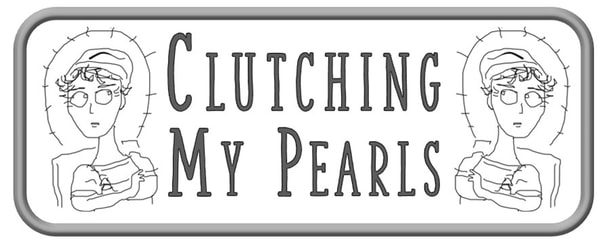
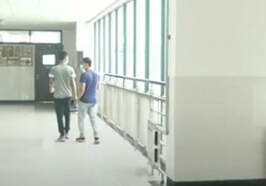
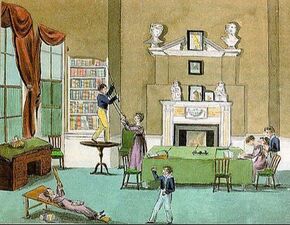
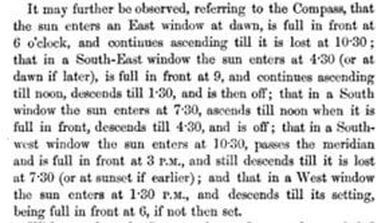
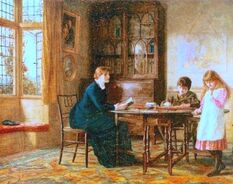
 RSS Feed
RSS Feed